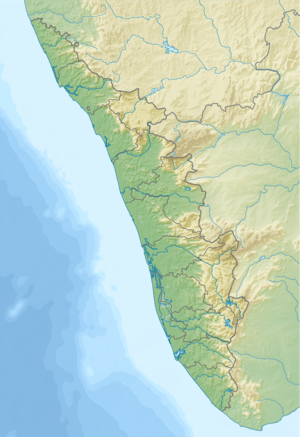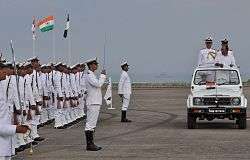Ezhimala (hill, Kannur)
Ezhimala, a hill reaching a height of 286 metres, is located near Payyanur, in Kannur district of Kerala, south India. It is a part of a conspicuous and isolated cluster of hills, forming a promontory, 38 km north of Kannur (Cannanore) .
| Ezhimala | |
|---|---|
Ezhimala | |
| Highest point | |
| Elevation | 286 m (938 ft) |
| Coordinates | 12°01′06″N 75°12′57″E |
| Geography | |
 Ezhimala Location of Ezhimala | |
| Location | Kerala, India |
| Country | India |
| Parent range | Independent, adjacent to the Arabian Sea |

As the former capital of the ancient Mushika Kingdom, Ezhimala is considered to be an important historical site. A flourishing seaport and center of trade around the beginning of the Common Era, it was also one of the major battlefields of the Chola-Chera Wars, in the 11th century. It is believed by some that Lord Buddha had visited Ezhimala.
Etymology
Th hills is also known as Elimala, Mooshika Sailam and Sapta Sailam.
The hill had been named Monte d'Eli by the Portuguese.[1] and was known as Mount Delly or Mount Eli to the British.

History
Ezhimala, which is part of Ramanthali panchayath, is one of the most important places in the recorded history of north Malabar. From before the period of known history, some chapters of the Ramayana and local Hindu legends associate the Ezhimala Hills with the famous epic, in particular with lord Hanuman.[2][3]
Ezhimala, Pazhayangadi, and several villages and towns in this region find plenty of mention in the extant Tamil Sangam Period's literature (500 BC to 300 AD). Pazhayangadi is the present corrupted form of its ancient name of Pazhi. Pazhi is mentioned as the ancient capital of King Udayan Venmon Nannan (known as Nannan or Nandan) of the Mushika or Kolathiri Royal Family. Though the Dynasty of Nannans was a cousin or sister dynasty of the Cheras and Pandyas and Cholas, warfare among them was nearly consistent, and the period of Nannan was no exception.[4][5][6][7] There are texts that speak of Nannan fighting heroic battles at Pazhi against the Chera Kings who invaded his kingdom (Kolathunadu). Eventually, Nannan was killed in battle by the Chera king, Narmudi Cheral. Like the other kings of the then Tamilakam cultural polity, Narmudi Cheral was a great patron of scholars and poets, and he once gifted his court-poet, Kappiyattu Kappiyanar with 40 lakhs gold coins, as a token of his poetic genius.
Extant Tamil Sangam texts describe the glory and wealth of the ancient Pazhi in the highest terms.[8] Sangam Era poets, as well as Classical Tamil poets of later centuries, like Paranar speak of the wealth of Pazhi in the greatest degree. One of the Sangam pieces, Akam 173 speaks of "Nannan's great mountain slopes where gold fields abound, and long bamboos dried in the Sun burst and released the unfinished pearls."[8] Noted scholar, Elamkulam Kunjan Pillai states that "It is from Kottayam (of North Malabar) and Cannanore regions of old Ezhimalainad that innumerable Roman (gold) coins have been excavated. On one (single) occasion (gold) coins that could be carried by six porters were obtained. These coins were found to belong to the period down to 491 AD".[8]
Ezhimala was also a flourishing seaport and center of trade at least by the start of the Common Era; and later was also one of the major battlefields of the series of Chola-Chera Wars in the 11th century; some believe that Lord Buddha had visited Ezhimala.
Mooshika Vamsham, written by Athulan in the 11th century, throws light on the recorded past of the Mushika Royal Family up until that point.[9][10] The first recorded king of Mooshika Vamsham (the Mooshika Dynasty) was Ramaghata Mooshika and his capital most probably was Pazhi (ancient Pazhayangadi). Athulan describes the later kings of this dynasty who are now better known as the Kolathiri Dynasty. King Ramaghata Mooshika's successors shifted their capital to Ezhimala, Valabhapattanam (Valapattanam), and eventually Chirakkal, among other nearby places, over the following centuries.
Indian Naval Academy
The Prime Minister, Dr Manmohan Singh, inaugurated the Indian Naval Academy in Ezhimala, which is the largest in Asia, on 8 January 2009. This institution trains officer candidates of the Indian Navy and the Indian Coast Guard.[11]
Transportation
The national highway passes through Perumba junction. Mangalore, Goa and Mumbai can be accessed on the northern side and Cochin and Thiruvananthapuram can be accessed on the southern side. The road to the east of Iritty connects to Mysore and Bangalore. The nearest railway station is Payyanur on Mangalore-Palakkad line. There are airports at Mangalore, Kannur and Calicut.
See also
- Mount Formosa
- Ramanthali inscriptions
- Kannur
- Payyanur
- Mushika Kingdom
- North Malabar
- Malabar (Northern Kerala)
- Kerala
- Kannur District
- Mangalore
- Indian Naval Academy
References
- Edgar Thurston (1913). The Madras Presidency. Cambridge University Press. p. 167.
- Murkot Ramunny (1 January 1993). Ezhimala: The Abode of the Naval Academy. Northern Book Centre. pp. 23–. ISBN 978-81-7211-052-9.
- Kerala (India); C. K. Kareem (1976). Kerala District Gazetteers: Palghat. printed by the Superintendent of Govt. Presses.
- Indian History. 1988. ISBN 9788184245684.
- "marriage+alliances" "Glimpses of Tamil civilization". 1994.
- Leela Devi, R. (1986). "History of Kerala".
- Congress, Indian History (1981). "Proceedings of the Indian History Congress".
- Ramunny, Murkot (1993). Ezhimala. ISBN 9788172110529.
- "Ouch, Something seems wrong!!".
- "Archived copy" (PDF). Archived from the original (PDF) on 10 April 2009. Retrieved 20 March 2009.CS1 maint: archived copy as title (link)
- http://pib.nic.in/release/release.asp?relid=46464&kwd=
External links
| Wikimedia Commons has media related to Ezhimala. |